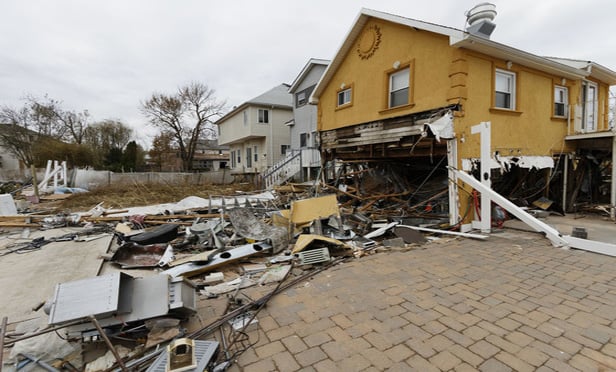Features

After a Hurricane: Can the Property Manager Be Blamed for a Lessee's Losses?
The recent decision in <i>Sears Roebuck & Co. and Kmart Corp. v. W/S Lebanon LLC</i> seems timely in light of the fact that commercial landlords, tenants and their insurance providers are grappling with the problems caused by the extreme wind and rain of hurricanes. Here's what happened in that case.
Features

DRaaS: How It Takes a Law Firm's DR Beyond Insurance
With expectations for an always-on law firm, significant challenges within the legal industry to maintain competitiveness and perform due practice for cybersecurity and other disaster scenarios come from both clients and regulatory bodies. A comprehensive approach with an end-to-end availability strategy is imperative to mitigate the threats of downtime. And yet, this is easier said than done.
Features

Managing Cyber Risks in Medical Practices
<b><I>Part Two of a Two-Part Article</I></b><p>Astonishing computing power lets health care providers harness vast computing resources to drive their business plans, manage treatment protocols and crunch data to boost their practices. However, unintended consequences arise and, in the case of computers, one such consequence is cyber peril.
Features

Home Insurance May Cover Jealous Husband's Attack on Third Party
A man returns home unexpectedly, finds his wife with another man, and shoots him. It's an unfortunate chain of events, but certainly not unheard of. What <I>is</I> unusual is how the case of a love triangle like this one could lead to an Eleventh Circuit decision about homeowners' insurance.
Features

Preet Bharara Highlighted Insurance Fraud
Over nearly eight years as U.S. Attorney for the Southern District of New York, Preet Bharara became recognized as a powerful prosecutor in many areas, including government corruption and white-collar crime. Another subject for which he certainly deserves mention is his strong record helping to fight insurance fraud in New York.
Features

Untangling the Mystery of Cybersecurity Insurance
IT security professionals used to warn that only two types of businesses exist: those that have been hacked, and those that will be. Now, many are even more pessimistic, and divide the world's businesses into companies that know that they have been hacked, and those that don't. Law firms are juicy targets with all the personal identifiable information (PII) contained in client files. Intellectual property practices are especially attractive to cyber thieves because of the value of patent, trademark and trade secret information.
Features

Creditor Exclusion<br><b><i><font="-1">The Perils of D&O Coverage</b></i></font>
The U.S. Court of Appeals for the Fifth Circuit recently held that a Creditor Exclusion provision in D&O insurance policies may result in significant limitations on the coverage provided to the D&Os when the underlying dispute is with a creditor acting in its creditor capacity.
Features

Cybersecurity Insurance<br><b><i><font="-1">Untangling the Mystery</b></i></font>
High-profile breaches have encouraged many businesses to proactively assess their cyber liabilities, and implement prevention and response plans. Fortunately, there are more technology options available to protect businesses than ever before, and both the U.S. government and private industry have made great strides in understanding and combating some of the most common cyber threats.
Features

Cyberinsurance Considerations for Law Firms
Law firms spend a lot of time and effort to protect their clients' interests, but often overlook routine protection and security of clients' (and their own) data. While not a cure-all for data security risks, one important component to consider in putting together a comprehensive data security program is cyber insurance, as most general liability policies and professional liability policies now expressly exclude coverage for data breach claims.
Features

The Bermuda Form
<b><i>Declaring an Integrated Occurrence (or Not)</b></i><p>Many Fortune 500 companies' product liability insurance programs use the Bermuda Form to insure alleged bodily injury and property damage. The Bermuda Form has many characteristics distinct from standard commercial general liability (CGL) policies. Knowing its intricacies is essential for any coverage lawyer involved in large-scale coverage analysis and disputes.
Need Help?
- Prefer an IP authenticated environment? Request a transition or call 800-756-8993.
- Need other assistance? email Customer Service or call 1-877-256-2472.
MOST POPULAR STORIES
- The DOJ's New Parameters for Evaluating Corporate Compliance ProgramsThe parameters set forth in the DOJ's memorandum have implications not only for the government's evaluation of compliance programs in the context of criminal charging decisions, but also for how defense counsel structure their conference-room advocacy seeking declinations or lesser sanctions in both criminal and civil investigations.Read More ›
- The DOJ's Corporate Enforcement Policy: One Year LaterThe DOJ's Criminal Division issued three declinations since the issuance of the revised CEP a year ago. Review of these cases gives insight into DOJ's implementation of the new policy in practice.Read More ›
- Use of Deferred Prosecution Agreements In White Collar InvestigationsThis article discusses the practical and policy reasons for the use of DPAs and NPAs in white-collar criminal investigations, and considers the NDAA's new reporting provision and its relationship with other efforts to enhance transparency in DOJ decision-making.Read More ›
- Don't Sleep On Prohibitions on the Assignability of LeasesAttorneys advising commercial tenants on commercial lease documents should not sleep on prohibitions or other limitations on their client's rights to assign or transfer their interests in the leasehold estate. Assignment and transfer provisions are just as important as the base rent or any default clauses, especially in the era where tenants are searching for increased flexibility to maneuver in the hybrid working environment where the future of in-person use of real estate remains unclear.Read More ›
- Developments in Distressed LendingRecently, in two separate cases, secured lenders have received, as part of their adequate protection package, the right to obtain principal paydowns during a bankruptcy case.Read More ›
